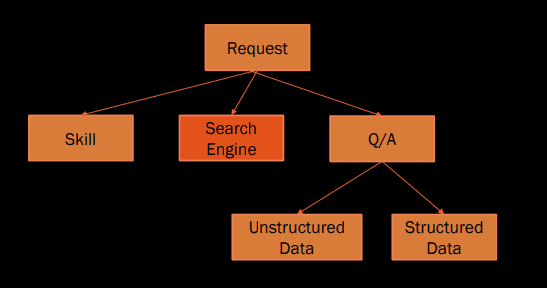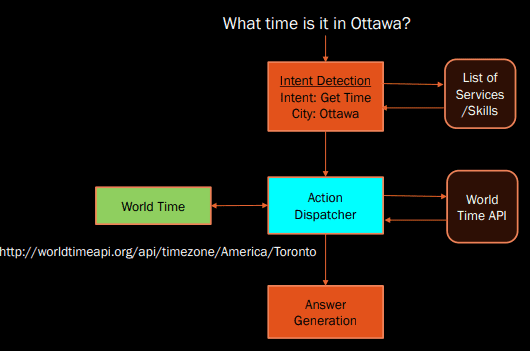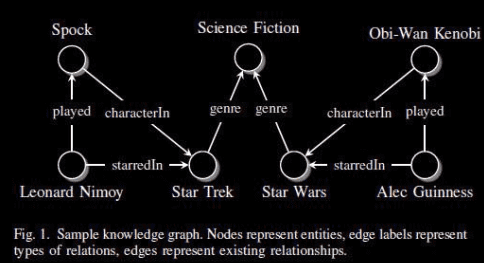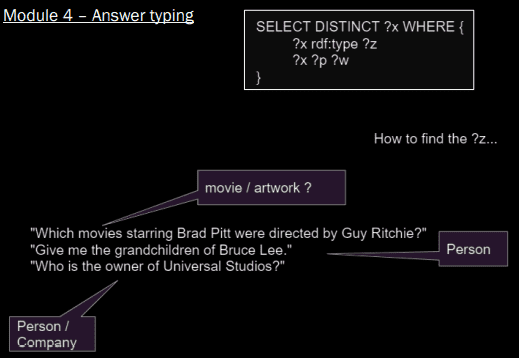Fulfillment
Problem Definition
Part of voice assistant that does the action, the act of fulfillment.
In some cases intent detection can also be joined to fulfillment / action.
Exploring Service APIs
An Action Dispatcher calls a service based on a predefined list of services.
In the above example, Ottawa isn't recognized by the API, so we get the nearest applicable city.
Question Types and Answer Types
Question Types
Factoid question:
- Questions that ask about a fact.
- Who was the first man in space?
List questions:
- Questions that ask for a list answer
- Give me all cities in Germany
Yes/No questions:
- Was Margaret Thatcher a chemist?
Definition questions:
- Questions that ask for a definition
- Who was Tom Jobim?
Evaluative or comparative questions:
- asking about comparisons
- What is the difference between impressionism and expressionism?
Association questions:
- asking about the association of one thing to another
- What is the connection between Barack Obama and Indonesia?
Explanation/Justification questions:
- Why did the revenue of IBM drop?
Process questions:
- asking for some sort of methodology
- How do I make a cheesecake?
Opinion questions:
- What do most Americans think about gun control?
Answer Typing
Answer should match to the type of question that is being asked.
Sometimes the answer could be a Person, Place or Thing or for more complex questions usually a descriptive text is provided.
Question Answering
Question answering systems differ with respect to the data source(s) they are able to process to derive an answer.
On the one hand side, they usually consume a specific type of data:
- Structured data, e.g. relational databases and linked data
- Semi-structured data, e.g. XML documents
- Unstructured data, e.g. text documents
Hybrid question answering systems are able to process a combination of two or more of the types of data mentioned above.
Questions Answering on Text Data
Question Answering
When working on unstructured data (text-based), QA is often seen as an hybrid between Information Retrieval, and NLP.
IR focuses on Document Retrieval.
QA tries to actually answer a question, by finding a text passage that contains the answer.
Two categories of QA: • Open-domain QA • Text comprehension QA
Open Domain QA
Examples:
- What are some ways to encourage oneself to step out of their comfort zone?
- What kind of books do you enjoy reading the most?
- How do I invest money into the stock market?
- What is actually a data science?
- Does tea contain caffeine?
Approach:
- Find the closest question
- this becomes a paraphrase finding problem
QA on Structured Data
Knowledge Graphs
A knowledge graph is a knowledge base that uses a graph-structured data model or topology to integrate data.
Linked Open Data Cloud
Open source of a large knowledge graph, found here.
Triples
You can represent data in knowledge graphs as triples.
For example the earlier knowledge graph can be represented as:
- Leonard Nimoy, played, Spock
- Lenoard Nimoy, starredIn, Star Trek
- Spock, characterIn, Star Trek
- Star Trek, hasGenre, Science Fiction
- Star Wars, hasGenre, Science Fiction
Baseline system
Various modules that could be useful in our system:
- Entity search
- Property search
- Implicit properties - noun compounds
- Answer typing
- SPARQL templates
- Use of filters
Module 1 - Entity Search
"Which movies starring Brad Pitt were directed by Guy Ritchie?" "Give me the grandchildren of Bruce Lee." "Who is the owner of Universal Studios?"
Module 2 - Explicit property search
"Which movies starring Brad Pitt were directed by Guy Ritchie?" "Give me the grandchildren of Bruce Lee." "Who is the owner of Universal Studios?
Module 3 - Implicit property search / Noun compounds

Module 4 - Answer typing
Module 5 - Template selection
SELECT DISTINCT ?x WHERE {?x rdf:type ?z?x ?p ?w}
Module 6 - SPARQL filters
How to know that we need filters (ORDER, COUNT, etc) and what information are they typically on?
Examples:
- "Show me all basketball players that are higher than 2 meters."
- "Which volcanos in Japan erupted since 2000?"
- "Which companies have more than 1 million employees?"



